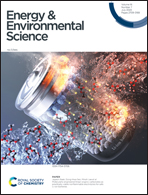Laser-controlled tandem catalytic sites of CuNi alloys with ampere-level electrocatalytic nitrate-to-ammonia reduction activities for Zn–nitrate batteries†
Abstract
The clean production of electric energy and ammonia (NH3) is an inevitable requirement of modern industrial development. In this work, we synthesized CuNi alloy nanoparticles on a Cu foil (CuNi NPs/CF) by a facile and fast laser irradiation method as the integral cathode for efficient electrocatalytic reduction of nitrate (NO3−) into NH3 (NIRR). As a result, the obtained CuNi NPs/CF with tandem catalytic sites exhibits ampere-level NIRR performance with the highest NH3 yield rate of 94.57 mg h−1 cm−2 and a faradaic efficiency (FE) of ∼97.03% at −0.48 V vs. RHE, along with good stability in an ultrahigh NO3− concentration of 44.3 g L−1. The tandem configuration of the optimized NO3− binding energy on Cu and sufficient active hydrogen on Ni sites are vital for the NIRR. Furthermore, benefiting from the high NIRR activity, a galvanic Zn–NO3− battery with the highest reported power density of 70.7 mW cm−2 was constructed with the CuNi NPs/CF as the cathode. This work not only reveals the catalytic mechanism of bimetallic alloys for NO3− reduction but also realizes an efficient Zn–NO3− battery for NH3 synthesis and electric energy output.



 Please wait while we load your content...
Please wait while we load your content...